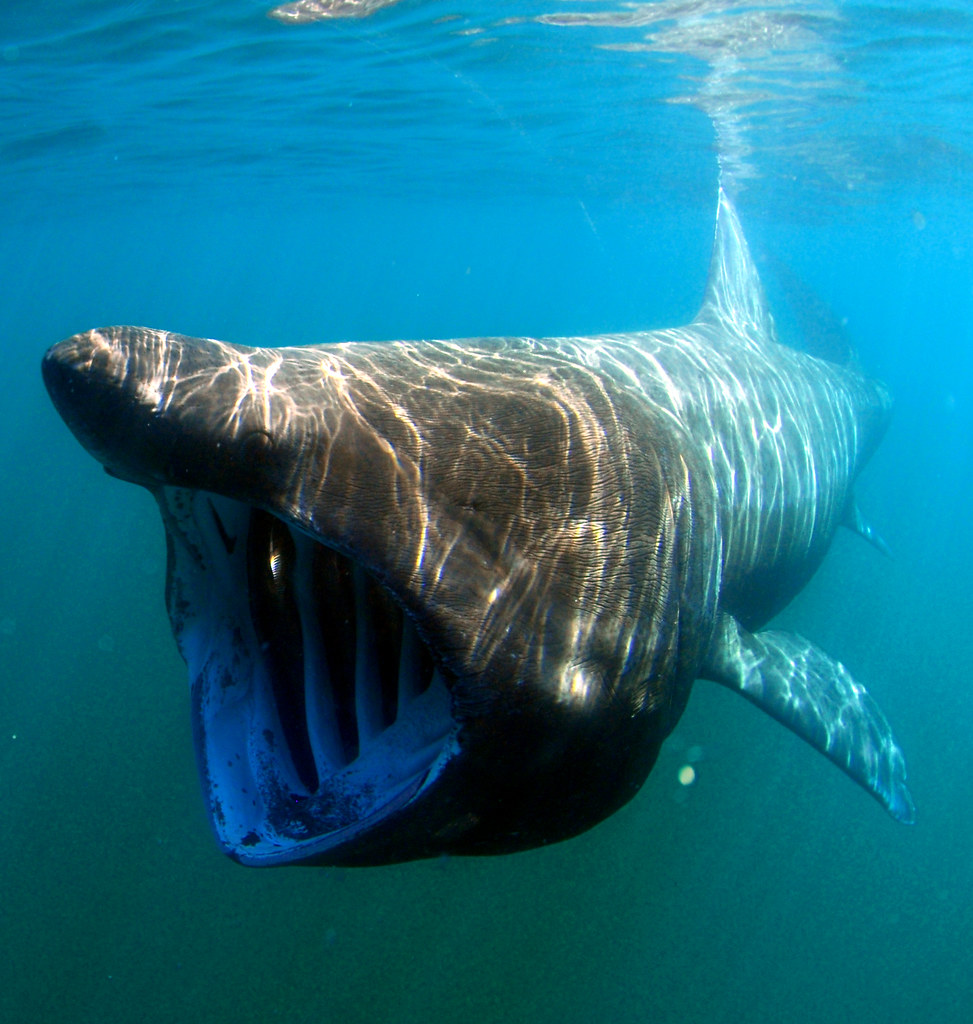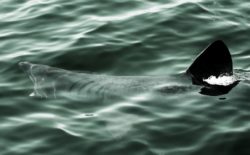
Sea Wonder: Basking Shark
The basking shark (Cetorhinus maximus) is the world’s second largest fish and one of the three species of plankton-eating sharks. Their size and appearance might seem intimidating but these creatures are actually quite docile and harmless.
Description
Basking sharks have a body shape similar to that of a great white shark and the two species are quite similar. We can easily distinguish a basking shark from a great white by its large jaw, smaller eyes, long gill slits that wrap nearly all the way around the shark’s head, and large but thinner body size. Basking sharks can grow to be upwards of 40 feet long and weigh more than five tons when fully grown – comparable to the size of a yellow school bus! Their faces end with a large, rounded snout and their gaping mouths stretch wide across their face with multiple rows of hundreds of teeny-tiny, rounded teeth. The skin on their backs range from dark gray to brown, but are most commonly a grayish-brown color, though their bellies are lighter in color – a permanent form of camouflage known as countershading.
Diet & Habitat
Basking sharks are filter feeders. Their diets are composed of primarily plankton, some of the ocean’s smallest organisms. To eat, they swim with their mouths wide open and allow water to pass through. This passive strategy differs from megamouth and whale sharks that actively pump water through their gills to breathe and feed. When feeding, basking sharks can filter as many as 2,000 tons of water per hour, which is about as much as an Olympic-sized swimming pool can hold! To survive, basking sharks need to eat millions of individual plankton per day, which can weight several hundred pounds. We don’t know of any natural predators of the basking shark, though large predatory sharks and killer whales may occasionally eat them.
Because of their dietary needs, basking sharks live where plankton is abundant – in the coastal and open ocean and near the water’s surface, though sometimes they enter brackish water areas. The deepest we know they can dive is nearly 3,000 feet. They are migratory animals that only stay in one area for a few months at a time. Their range includes both temperate and arctic waters in the northern and southern hemispheres. In the National Marine Sanctuary System, they live in and pass through the west coast sanctuaries and in Stellwagen Bank on the east coast. Recently, scientists sighted and tagged two basking sharks in Channel Islands National Marine Sanctuary in southern California, allowing NOAA scientists to track their movements and use collected data to learn more about the species.
Life History

Photo: NOAA
Basking sharks are gentle and generally solitary animals but are sometimes seen in small groups, usually during mating season in the early summer months when waters are warm and food is plentiful. They reproduce via internal fertilization and females incubate eggs in their uteruses. The eggs hatch internally and are born live, known as ovoviviparous reproduction. Gestation lasts as long as three years, which is the longest pregnancy of any vertebrate, though this may differ between populations in different areas of the ocean. Unlike whale sharks, their larger cousins, basking sharks give birth to only few, large babies. In fact, scientists think they give birth to the largest babies of all fish, including the great white shark.
Basking sharks are slow-moving, though they can perform athletic behaviors like breaching, or leaping out of the water. Given how much water they filter during feeding, basking sharks shed and renew the cartilaginous gill rakers that help them filter prey. Some populations of basking sharks seem to migrate south during the winter, but how far and why isn’t exactly clear.
Threats & Conservation
In the early and mid-1900s, basking sharks were a popular target for fisheries in the eastern and western Pacific. Their oil, vitamin rich livers, meat, and fins made them a desirable target, and their slow movements made them an easy target. In Canada, an official eradication program focused on hunting basking sharks because they were destroying fishing gear and interfering with commercial fishing activities.
Today, most fishing of basking sharks has stopped but they are still threatened by accidental bycatch in fishing gear and prey shortages due to commercial targeting of krill and other plankton species for use in dietary supplements. Scientists are still learning about basking sharks and the impacts climate change, warming waters, and ocean acidification may have on them. The International Union for Conservation of Nature (IUCN) lists them as vulnerable all throughout their range and endangered in the northeast Atlantic Ocean and north Pacific Ocean regions.

Basking shark in Stellwagen Bank National Marine Sanctuary. Photo: Richard Dolan
